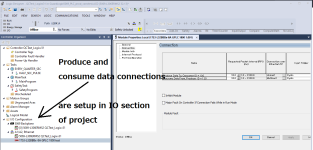celichi
Lifetime Supporting Member
Hello Ladies and Gents,
I have some PLC to PLC communications using Produce and Consume.
The data is not time sensitive, and I really only need a turn around of 1-2 seconds.
The current program has RPI set to 20ms, this seems overkill to me.
The IT group is saying that there is a lot of traffic (+200K packets in 5 minutes).
My instinct is telling me that 20ms is way to zippy for this, and I would like to set this to 1000 ms.
Am I heading in the right direction?
Also, can this be changed online in run, or do I have to save/upload --> go offline --> change RPI --> download.
Thanks in advance,
I have some PLC to PLC communications using Produce and Consume.
The data is not time sensitive, and I really only need a turn around of 1-2 seconds.
The current program has RPI set to 20ms, this seems overkill to me.
The IT group is saying that there is a lot of traffic (+200K packets in 5 minutes).
My instinct is telling me that 20ms is way to zippy for this, and I would like to set this to 1000 ms.
Am I heading in the right direction?
Also, can this be changed online in run, or do I have to save/upload --> go offline --> change RPI --> download.
Thanks in advance,






